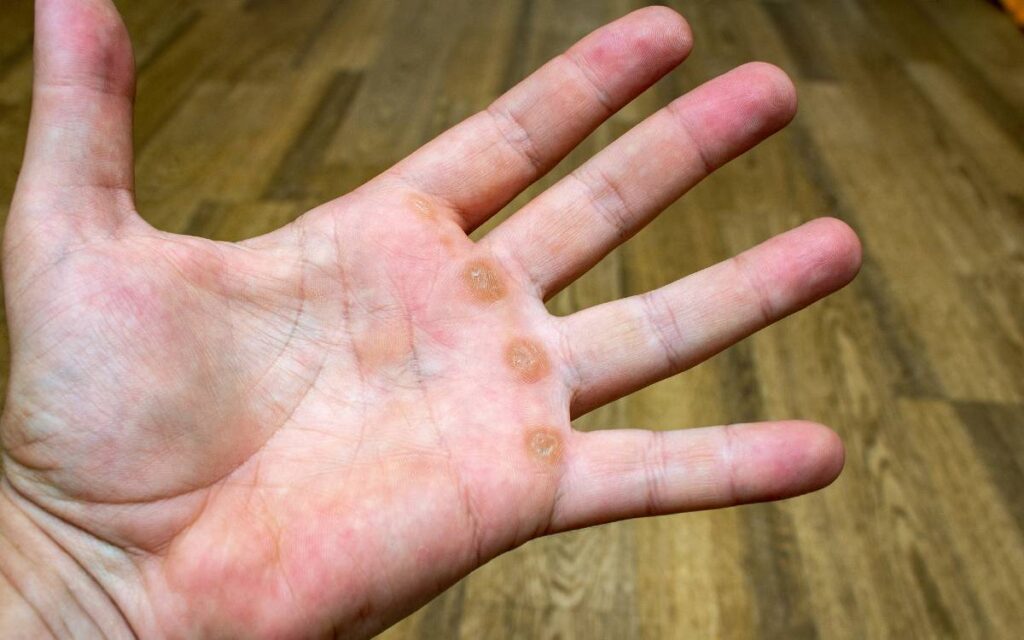One of the most common complaints by beginner guitarists is that they get sore fingertips when they start playing. It’s not a comfortable feeling and can even break your skin sometimes. That’s why you want to develop calluses as soon as possible.
So how do you go about developing guitar calluses?
- Start by practicing for short bursts, this helps to give your fingers a break
- Play on a steel string acoustic guitar and use thick-gauge strings. Thick gauge strings rub rather than cut like lighter gauge strings do
- When not playing your guitar, press on the edge of a credit card or something similar to get your fingers accustomed to the sensation
If you’re looking at how to build calluses for guitar, the following is a detailed guide on how you can do that, and by the end of this, playing the guitar will become a painless experience for you.
Post Contents
What are Calluses?

A callus is defined as a thick layer of skin that develops from consistent pressure and rubbing on the skin.
Gymnasts, weight lifters, and tradesmen often get them on their hands from bars and tools. People who work on their knees, like tilers, also get them on their knees.
Guitar calluses are on top of the fingertips on the hand as the guitarist plays chords and applies pressure on the fretboard strings. This tougher skin is developed over time as the softer skin keeps getting peeled off due to constant pressure and friction on the skin.
You could describe them as your body’s way of armoring itself from consistent peeling of the skin. To develop them, you do have to endure a period of pain as you start to develop thick calluses on your fingertips.
How to Build Guitar Calluses

The idea of forming calluses might sound painful, and in some ways, it is. But developing a callus can be compared to ripping off a band-aid. It may hurt at first, but once that period of pain is over, it’s unlikely to return, and it will prove beneficial when playing guitar for longer durations in the future.
There are several ways to grow your calluses faster, but it requires some short-term dedication and commitment. Here are a few things you should do to build calluses for guitar fast.
1) Frequent, Short Practice Sessions
As a beginner playing guitar, your calluses won’t have developed yet. Longer practice sessions are not only mentally draining but can also make your fingers hurt.
Instead, it’s better to go for 10-15 minute practice sessions 3-5 times a day rather than opting for a 2-hour session and not playing the guitar for the rest of the day. Longer sessions can also lead to carpal tunnel syndrome. If you’re experiencing extreme pain anywhere in your body while playing guitar, STOP and seek advice.
More frequent sessions of playing guitar of lesser duration are much more beneficial for learning and help accelerate the growth rate of your fingertip calluses. Extended sessions will only leave you with sore fingers and finger pain.
We have a complete detailed guide on how often you should play guitar. Check it out to find out more.
2) Play On an Acoustic Guitar
Most beginners start learning on acoustic guitars anyway. However, if you’re looking to play electric guitar, we still recommend starting with an acoustic one if you want to form calluses faster.
Most people who play the electric guitar adjust the guitar’s action and use light strings to make it easy to play. You can learn on an acoustic guitar and transition to an electric one smoothly, but learning on electric guitars and transitioning to acoustic guitars is significantly harder.
Electric guitar strings often have much lighter top strings, making pitch bends easier. But, their thin nature also means they’re very rough on the fingertips of new players.
An acoustic guitar with steel strings needs much more force to play and usually has a higher action. Learning to tolerate this for a more extended period while you avoid using nylon strings helps you grow your calluses faster.
Nylon strings can be softer on your fingers, but that softness also means calluses form much slower.
3) Use Medium or Heavy Gauge Strings, Not Light Gauge Strings
When you pick up the guitar the first time, you can do either of two things. One is to avoid sore fingertips by using lighter strings, but you also have the risk of cutting your finger tips since your calluses aren’t developed yet. Also, when calluses develop from light gauge strings, they’re smaller, and as a newbie, you may miss resting the finger in the callused spot when learning new chords.
The second option is to use medium or thicker strings. Heavy Gauge strings are less painful for soft fingertips and will help to develop calluses faster.
We recommend going for the latter option to develop calluses faster rather than just cutting up your finger with every guitar playing session.
You can familiarize yourself with the strings of a guitar to know which will cause you the most issues and become a more capable guitar player.
4) Trim Your Fingernails

When your fingernails hit the strings or the fretboard, they relieve the pressure from your fingertips. This slows down the process of growing calluses on your fingers. Longer fingernails can also lead to uncomfortable situations where you can tear off a piece of a nail. Long nails on your fretting hand can also cause issues with playing guitar correctly, so keep your nails trimmed.
You may often see guitarists chewing off their nails before playing. We don’t recommend chewing off your fingernails. Overdoing this can lead to infection, ingrown nails, or even bleeding if you over-chew your nails and expose the sensitive skin underneath. Instead, just use nail clippers and don’t cut your nails more than you need to. If you do bite your nails, use a nail file afterward to prevent damage to your fretboard.
Your strumming hand can have long fingernails if you wish. In fact, the fingerpicking guitar playing style becomes easier with long nails on that hand.
5) Rub Your Fingers in Downtime
To make the process of growing your calluses faster, you can also use several tricks to emulate the feeling of pressing on guitar strings throughout the day. You can do this by using the edge of a credit card to rub onto your fingertips. You can also emulate a similar feeling by pressing your thumbnail into your fingertips.
One way to build calluses is to buy a tool to help develop calluses quickly. These are generally made up of plastic or metal and emulate the feeling and the thickness of a guitar string.
6) Paint on a Fake Callus
If you’re looking for a quick temporary fix, you can opt to paint on a fake callus by coating a layer of material over your fingertips. Make sure the layer is thin but still thick enough to endure a guitar playing session. Many artists in the music industry use this trick if they accidentally rip a callus off so they can still play a show.
You can paint on a layer of super glue on your fingertip and let it dry to simulate a callus, or you can opt for healthier options like liquid band-aids. Do note that it’s fast but not genuine and can often slow down your progress when building calluses.
7) Dry Your Fingertips
You can accelerate the callus building process by using this tip by Eric Clapton. The master guitarist recommends that beginners dry their fingertips’ skin by using rubbing alcohol on cotton or alcohol wipes. This is known as “Eric Clapton’s secret elixir” This helps evaporate out the moisture from your skin, and it makes the process of growing thick skin on your fingertips faster.
Some people also use apple cider vinegar to create hardened skin.
You should avoid having sweaty fingers for a long time and avoid pruney fingers caused by more prolonged exposure to water. Wet fingers are your enemy, especially with warm water, so use cold water when washing your hands.
How Long Is the Process for Developing Calluses for Guitar?

As a beginner, it’s exciting to want to quickly build finger calluses and say goodbye to the initial pain when you first learn guitar.
If you practice a lot, then your calluses will become thicker faster. However, here is a general timeline on how much time it can take to develop your calluses.
You should expect to wait for three weeks to a month before you start to develop any decent fingertip calluses. You should expect pain in your fingertips to last around two weeks when you play guitar.
After the First Week
New guitar players will feel tenderness in their fingers and a feeling of uneasiness during this time. Ensure that you practice for at least 15-30 minutes a day. If you have the time, you can divide up your sessions in the day. For example, you can do three 10-minute sessions instead of one 30-minute session a day.
If you want to continue learning but can’t due to numbness in the fingers, you can opt to learn music theory or maybe spend time on the upkeep of your guitar.
After Two Weeks
By now, you won’t be experiencing the sharp, throbbing pain on your fingertips. You will be able to see your skin changing and getting harder by now, and the pain will start to become tolerable but won’t entirely go away.
After One Month
If you followed all of our steps correctly, you should have developed calluses by this time. If you had a good practice session, likely this issue doesn’t bother you anymore.
Sometimes a layer of skin might start peeling off, but it only reveals a newer, harder finger callus underneath.
Try not to pick at it and wait till it comes off on its own. If you pull it off, it will reveal soft skin underneath, and you won’t maintain calluses this way.
How to Care For Your Guitar Finger Calluses

You made it! Despite the hard work and minor inconveniences, you worked hard, and now you have fantastic finger calluses. But you must be thinking, now what? You’re able to play for hours, but there are a few things you need to keep in mind so you can ensure your calluses stay in the best shape.
If you have a guitar teacher who provides top-notch guitar lessons, they can also guide you on how to take proper care of your calluses.
1) Don’t Shave Down Your Calluses
It’s human nature to try to pick at the imperfections in the skin. That is why we often find ourselves nail-biting or pulling excess skin around our nails. As you start building your calluses, you will get the urge to mess with them. Before you begin doing this, remember your calluses are your friend, and you worked hard for days, even months, to get them. Don’t pick at them.
However, sometimes, you may need to file down your calluses, mainly if a rough edge develops and starts catching on the strings. This can lead to painful tears in the skin. Use a pumice stone and not an actual file to file down the skin. If a sharp edge sticks out, you can use nail trimmers to cut down that piece.
2) Don’t Press Too Hard on the Guitar Strings
Beginners usually have a habit of pressing down on the strings more than they should. Pressing down on the strings more than you should tires out your hands sooner, and you can end up with joint problems in the future. Not only that, but you can also end up with cuts and tears in your finger calluses.
All of that means downtime, meaning you will have to stop playing to let your calluses heal. This, in turn, can have a negative effect where you can end up losing your calluses.
Play the guitar with relaxed fingers and push down on the strings enough to just get a good sound out of them. If your fingertips hurt when pushing on the strings, even with the calluses, it’s a good indicator that you’re pushing on the strings too hard
3) Don’t Play With Wet Hands
When you stay in water for an extended amount of time, you can end up with soft pruney fingers, which will make your fingers soft. This can even happen if you apply a lot of lotion to your hands.
The worst thing you could do for your callus is to pick up a guitar at this time. Playing the guitar will cause your skin to get shredded, and it can start to peel in layers. Drying your fingers after this won’t help, so it’s best to let your hands fully dry before you begin to play.
4) Build Calluses on Your Entire Fingertip
You don’t want to grow calluses on just a tiny area on your fingertip. You want a callus that’s evenly spread on the entirety of your finger, so you can play the guitar. Playing chords perfectly when learning guitar requires using your fingertips at various angles, so it’s best to grow finger calluses all over your fingers.
To do this, you can spend a few minutes pressing different parts of your fingers onto the strings. We mentioned the credit card trick before, which you can do to ensure you have evenly spread calluses all over your fingers.
Keep Playing Guitar to Maintain Your Calluses

Initially, the process to build guitar calluses may seem painful and tedious. Eventually, you won’t even feel a bit of pain when playing the guitar. However, with a bit of patience and hard work, you can start to grow calluses on your fingertip within a month. At first, you couldn’t play the guitar correctly for more than a few minutes, but in the end, you should be able to play the guitar for hours without any finger pain.







